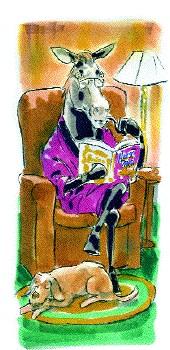|
phosphorus and starch are digested. Interestingly, an interference with the
hindgut will also lead to an inability to properly synthesize vitamin B.
 In nature, horses will graze and the digestive system
will do its job uninterruptedly. Yet as the horse is
becoming accustomed to exercise, work, and other highly
demanding activities, the feed it receives is also altered
to include high amounts of grain to provide for the
increased energy need. Unfortunately, the increase in grain
feedings has also led to an increase in digestive problems. Consider for example that a meal that consists mostly of
grain will make its way through the foregut rather quickly
and then move into the hindgut. The high starch content will
cause fermentation to produce large amounts of lactic acid
which may eradicate the very microorganisms charged with
fermentation. The result is laminitis or possibly colic.
Many horse owners seek to counteract this from happening by
including yeast cultures into the supplementation they
provide to the dietary regimen. In nature, horses will graze and the digestive system
will do its job uninterruptedly. Yet as the horse is
becoming accustomed to exercise, work, and other highly
demanding activities, the feed it receives is also altered
to include high amounts of grain to provide for the
increased energy need. Unfortunately, the increase in grain
feedings has also led to an increase in digestive problems. Consider for example that a meal that consists mostly of
grain will make its way through the foregut rather quickly
and then move into the hindgut. The high starch content will
cause fermentation to produce large amounts of lactic acid
which may eradicate the very microorganisms charged with
fermentation. The result is laminitis or possibly colic.
Many horse owners seek to counteract this from happening by
including yeast cultures into the supplementation they
provide to the dietary regimen.
These yeast cultures supercharge the microorganisms in
the hindgut which are charged with breaking down the fiber,
thus reducing the buildup of acid and balancing the chemical
compounds found within the animal’s gut. This, in turn, will
permit the hindgut to adequately digest the feed and absorb
the nutrients into the body. For a foal this is a most
important occurrence since the formation of strong bones and
muscle tissues rests on the metabolism’s ability to properly
use all of the nutrients present in the feed. In addition to
the foregoing, it provides the much needed chemical balance
between phosphorus and calcium within the animal’s system.
As you can see, yeast cultures are a most valuable tool for
keeping the hindgut functioning at optimum capacity, even
when the dietary intake is not as close to the natural state
of the horse’s nutritional need.
Of course, yeast cultures are also of tremendous
importance to mares and their foals, since the milk from a
lactating mare that ingested yeast cultures is more packed
with potent nutrients than that of a mare that received no
such supplementation. The results are healthier foals that
grow quicker and even taller! It is truly surprising how
many positive results there are reported simply because
yeast cultures are added to a balanced dietary regimen.

|